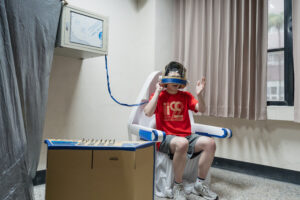第22屆智慧鐵人創意競賽(下稱:智鐵)於7月28日在屏東大學盛大開幕,進入72小時不間斷的賽程前,智慧鐵人創意競賽計劃主持人暨國立臺灣大學土木工程學系教授劉格非向小鐵人們公布第22屆智鐵決賽的主軸任務主題:「情緒博物館」。劉格非提到,2017年,加州大學伯克利分校的研究員Alan Cowen和Dacher Keltner整理出人類能識別多達27種不同的情緒,每個人對於情緒的處理方式對生活產生了極大的影響。而人們往往對於不同情緒有不同的誤解,因此造成調適上的困難。
The 22nd IICC kicked off in grand fashion on July 28 at National Pingtung University. Before launching into an intense 72-hour non-stop competition, the challenge’s project director, Professor Ke-Fei Liu of National Taiwan University Department of Civil Engineering, revealed this year’s main project for the finals: ” Museum of Emotions.”
Professor Liu referenced a 2017 study by UC Berkeley researchers Alan Cowen and Dacher Keltner, which identified up to 27 distinct human emotions. He emphasized how an individual’s way of processing emotions significantly affects their life. However, people often carry misconceptions about certain emotions, which makes emotional adjustment more difficult.
劉格非表示,本次主軸任務需要小鐵人們從「嫉妒、悲傷、焦慮、羞愧、畏懼」五種情緒中,挑選三種作為情緒博物館的展覽主題。並針對每一種情緒設計一件情緒展品,不論是一件象徵物,還是一段聲音,抑或是一段短劇。此外,還需要有一位導覽員介紹展品,且帶領觀眾們重新理解情緒的價值與存在的意義。最特別的是,小鐵人們需要設計一個「情緒修復裝置」或「情緒重啟空間」,幫助觀眾們找回情緒地平衡。
For this year’s main challenge, participants were asked to select three emotions from five options—jealousy, sadness, anxiety, shame, and fear—as the focus for their emotion-themed museum exhibition. Each emotion had to be represented by an exhibit piece—be it a symbolic object, a soundscape, or a short performance. A designated guide was also required to lead the audience through the exhibit and help them reframe the value and purpose of each emotion. Most notably, teams were also challenged to create a “Healing Device” or an “Emotional Reset Space” to help visitors restore emotional balance.

“Wisdom Iron Bear” created an emotional healing device called the “Memory Fragment Recovery Machine.”
參賽隊伍《智慧鋼鐵熊》隊長彭昇揚提及,他們在參賽前有先研究過歷屆主軸題目,而他們發現前幾屆的主軸都可以很直觀的聯想到製作的道具及理念。但這次的「情緒博物館」一題,而是比較抽象的題目,需要花更多的時間去詮釋情緒後,再具體化。
Peng Sheng-Yang, team leader of “Wisdom Iron Bear,” shared that they had studied past themes in preparation for the competition. They observed that previous topics typically led to more concrete objects and clearer design directions. In contrast, this year’s “Museum of Emotions” required deeper interpretation of abstract feelings before any tangible ideas could be formed.
本次在國內組及國際組受到評審一致好評的《Drama Queen》,以雙生花作為核心概念,選擇了「尷尬、焦慮、嫉妒」三種情緒作為展覽主題,且以精美的手作雙生花,得到全場青睞。《Drama Queen》隊長洪鈺瑄分享,雙生花的概念就是世界上的所有東西,都會有相互依存的一面。因此他們想找出每一個情緒可能對應到的另一面,提醒觀眾們在遇到情緒時,透過換位思考,或許能看到不一樣的視野。
Winning praise in both the national and international divisions, the team “Drama Queen” built their entire exhibition around the concept of “Twin Flowers.” They chose embarrassment, anxiety, and jealousy as their focus emotions and impressed judges with delicately handcrafted twin flower models. Team leader Hong Yu-Xuan explained that twin flowers represent the idea that everything in the world has a dependent, opposing counterpart. The team used this concept to reveal the constructive and enlightening sides of each emotion, encouraging visitors to shift perspectives and discover new ways of seeing their feelings.

“Drama Queen” built their own Museum of Emotions with exquisite exhibits and a novel concept.
以「情緒博物館」為題的主軸任務,不僅是要讓小鐵人們重新理解那些被誤解的情緒,更是要讓小鐵人們思考當這些情緒出現在我們生活周遭時,該怎麼使用專屬的「情緒修復裝置」成為情緒的主人,從中學會與情緒和平共處,擁抱每一份真實的感受。(記者楊采璇、黃子宜/屏東採訪報導)
Ultimately, the “Museum of Emotions” was not just about redesigning misunderstood emotions—it was a challenge for the Little Ironmen to reflect on how to take ownership of their emotional lives. By designing personal emotional repair tools and spaces, participants learned how to coexist with their emotions and embrace the authenticity of every feeling.